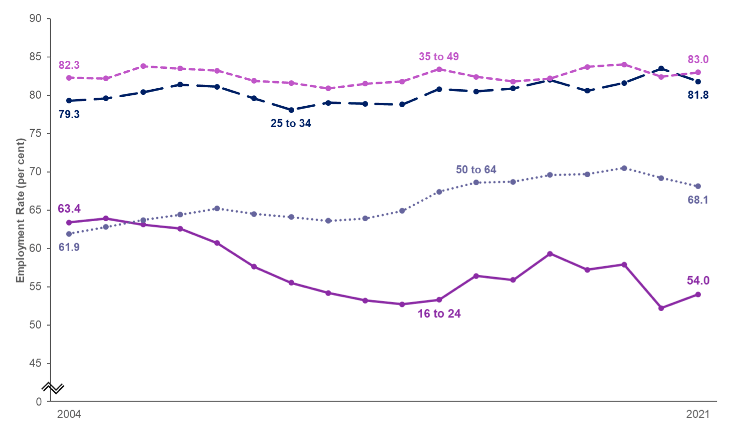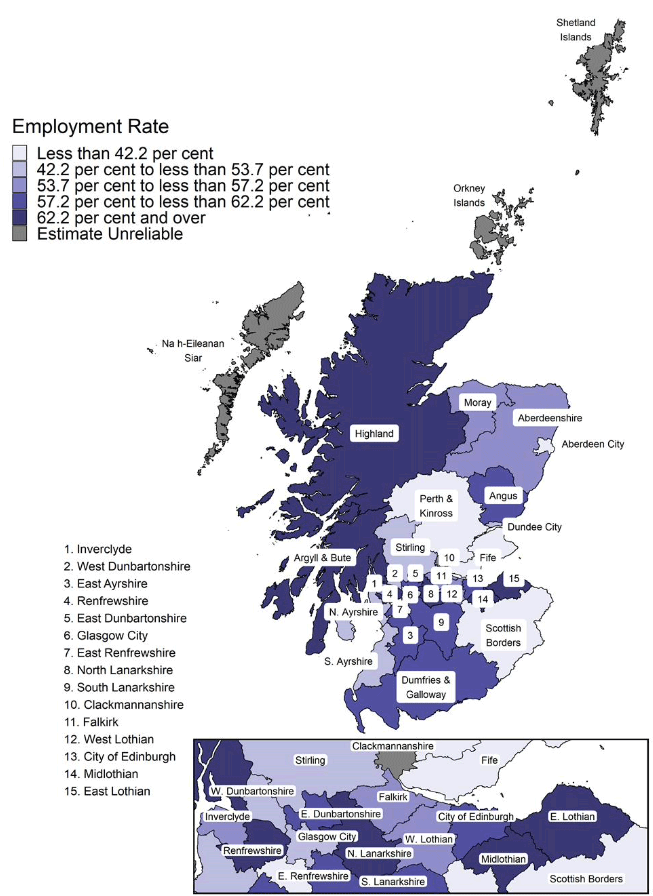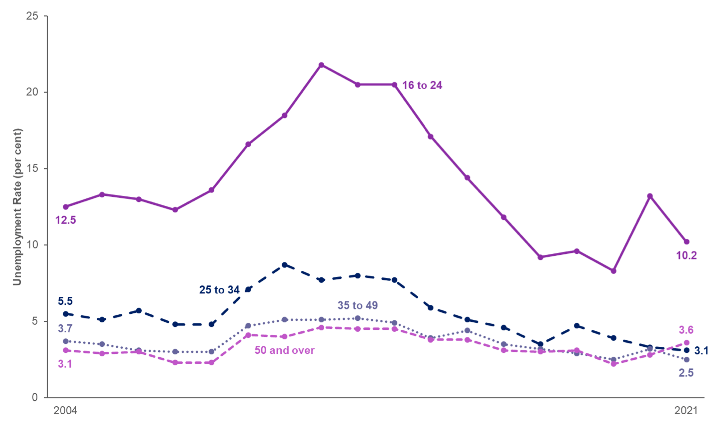Scotland's Labour Market: People, Places and Regions – Protected Characteristics. Statistics from the Annual Population Survey 2021
Summary publication of results from the ONS Annual Population Survey January to December 2021, presenting analysis on the labour market by protected characteristics including age, sex, disability and ethnicity.
This document is part of a collection
Age
More information about estimates of 16 to 24 year olds is available in the About this publication section.
Employment
Since 2006, the employment rate for 16 to 24 year olds has been consistently lower than the employment rate for any other age group. This is due to higher numbers of people aged 16 to 24 being in education.
The employment rates for 25 to 34 year olds and 35 to 49 year olds have been fairly stable across the calendar series. However, the rates were slightly lower in the years following the 2008 recession (2009 to 2013). The estimated employment rate for 25 to 34 year olds was 81.8 per cent in 2021. This was slightly higher than in 2019 (81.6 per cent). The estimated employment rate for 35 to 49 year olds was 83.0 per cent. This was lower than in 2019 (84.0 per cent).
The estimated employment rate for those aged 50 to 64 had increased throughout the economic recovery from the 2008 recession to 70.5 per cent in 2019. However, the employment rate for 50 to 64 year olds had decreased over the last two years to 68.1 per cent in 2021.

Source: Annual Population Survey, January to December datasets, ONS
Local Authority area estimates
There are long-standing variations in employment rate estimates across Scotland's local authorities.
16 to 24 year olds
Estimates for local authority areas considered unreliable are not included. The four areas affected are:
- Clackmannanshire
- Na h-Eileanan Siar
- Orkney Islands
- Shetland Islands
In 2021, the highest employment rate estimates for 16 to 24 year olds were seen in:
- North Lanarkshire (70.0 per cent)
- Renfrewshire (67.4 per cent)
- Highland (65.6 per cent)
The lowest employment rate estimates for 16 to 24 year olds were seen in:
- Perth and Kinross (36.2 per cent)
- East Renfrewshire and Scottish Borders (both 39.6 per cent)
- Fife (40.0 per cent)
Estimates for Highland, Perth and Kinross, East Renfrewshire, Scottish Borders and Fife are based on small sample sizes. They may be less precise and users should be cautious when quoting them.

Source: Annual Population Survey, January to December 2021, ONS
© Crown copyright and database right 2022. All rights reserved. Ordnance Survey Licence number 100024655.
50 year olds and over
In 2021, the highest employment rate estimates for those aged 50 and over were seen in:
- Aberdeen City (50.1 per cent)
- Na h-Eileanan Siar (46.4 per cent)
- East Lothian (45.2 per cent)
The lowest employment rate estimates for those aged 50 and over were seen in:
- North Ayrshire (32.2 per cent)
- East Dunbartonshire (33.8 per cent)
- Fife (34.9 per cent)

Source: Annual Population Survey, January to December 2021, ONS
© Crown copyright and database right 2022. All rights reserved. Ordnance Survey Licence number 100024655.
Unemployment
Across the series, the unemployment rate for those aged 16 to 24 has been consistently higher than the unemployment rate for any other age group.
Since 2019 (pre-pandemic), the unemployment rate for those aged 16 to 24 and 50 and over had increased by 1.9 percentage points (pp) and 1.4 pp, respectively. While the unemployment rates for those 25 to 34 and 35 to 49 had decreased by 0.8 pp and 0.1 pp, respectively.

Source: Annual Population Survey, January to December datasets, ONS
Duration of unemployment
The proportion of unemployed people who were long-term unemployed increases with age. In 2021, there were 16,300 unemployed people aged 50 and over who were unemployed for 12 months or more (50.9 per cent of all unemployed people aged 50 and over).
Economic Inactivity
The economic inactivity rate for 16 to 24 year olds has been increasing over time. This is mainly due to increases in the proportion of 16 to 24 year olds in full-time education. The inactivity rate for those aged 50 to 64 had been decreasing over time. However, the inactivity rate for this age group has increased since 2019.
The inactivity rate for 25 to 34 year olds has remained around 15 per cent over time. However, there was a reduction in the inactivity rate for 25 to 34 year olds in 2020. This was due to an increase in the employment rate for this age group in 2020. For those aged 35 to 49, the inactivity rate remained relatively constant, at around 14 per cent, over time.

Source: Annual Population Survey, January to December datasets, ONS
Contact
Email: lmstats@gov.scot
There is a problem
Thanks for your feedback